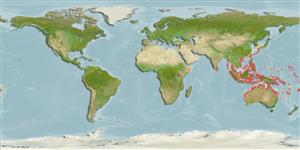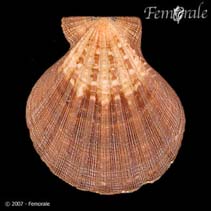Decatopecten radula (Linnaeus, 1758)
Flatribbed scallop| Native range | All suitable habitat | Point map | Year 2050 |

|
| This map was computer-generated and has not yet been reviewed. |
| Decatopecten radula AquaMaps Data sources: GBIF OBIS |
Classification / Names Common names | Synonyms | CoL | ITIS | WoRMS
| Pectinida | Pectinidae
Environment: milieu / climate zone / depth range / distribution range Ecologia
; distribuzione batimetrica 0 - 20 m (Ref. 348). Tropical
Distribuzione Stati | Aree FAO | Ecosystems | Presenze | Introduzioni
Indo-West Pacific: from India to Melanesia; north Japan and south to Queensland and New Caledonia.
Length at first maturity / Size / Peso / Age
Maturity: Lm ? range ? - ? cm Max length : 9.5 cm SHL maschio/sesso non determinato; (Ref. 348); common length : 7.0 cm maschio/sesso non determinato; (Ref. 348)
Short description Morfologia
Shell solid, medium sized, higher than long, elongate-ovate in outline. Both valves convex, the right (lower) valve more inflated than the left (upper) valve. Ears subequal in size and shape. Right anterior ear with a slight byssal notch anteroventrally, devoid of ctenolium. Outer sculpture of about 10 or 11 rounded radial folds (9 to 13) on each valve, with numerous, much smaller, secondary radial riblets that are set with densely and finely imbricated transverse scales, giving a rather strongly scabrous aspect. Surface of ears with distinct radial ridges (more developed on right anterior ear). Hinge line quite long, about 2/3 of shell length, with shallow marginal ridges. Interior of valves shiny, with a flattened radial sculpture corresponding with the outer folds. Colour: outside of shell off-white to interior satin white, with dark brown on the hinge line.
Attached to rock, coral and other hard objects. Common on coarse sand in coral reef areas. Intertidal and shallow subtidal waters (Ref. 348).
Life cycle and mating behavior Maturità | Riproduzione | Deposizione | Uova | Fecundity | Larve
Members of the class Bivalvia are mostly gonochoric, some are protandric hermaphrodites. Life cycle: Embryos develop into free-swimming trocophore larvae, succeeded by the bivalve veliger, resembling a miniature clam.
Main reference
Bibliografia | Coordinatore | Collaboratori
Poutiers, J.M. 1998. (Ref. 348)
IUCN Red List Status (Ref. 130435)
CITES status (Ref. 108899)
Not Evaluated
CMS (Ref. 116361)
Not Evaluated
Threat to humans
Harmless
Human uses
| FishSource |
Strumenti
Informazioni ulteriori
Fonti Internet
BHL | BOLD Systems | CISTI | DiscoverLife | FAO(Publication : search) | Fishipedia | GenBank (genome, nucleotide) | GloBI | Gomexsi | Google Books | Google Scholar | Google | PubMed | Tree of Life | Wikipedia (Go, ricerca) | Zoological Record
Estimates based on models
Preferred temperature
(Ref. 115969): 25 - 29.3, mean 28.6 (based on 2509 cells).



